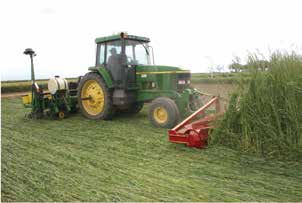chAPter 16 reduCing tillage
Figure 16.6. Left: A no-till seed drill requires no tillage or seedbed preparation for narrow-seeded crops or cover crops. Right: The cross-slot opener used in no-tillage planters. The disk slices soil, the inverted T blade al ows seed and fertilizer placement on opposite ends of disk, and the packer wheels (right side) close and firm the seedbed.
receives organic materials like cover crop residue,
row crops) or seed drill (for narrow-seeded crops; figure
compost, or manure. A spader is also an actively rotated
16.6). This system represents the most extreme change
tillage tool, but the small spades, similar to the garden
from conventional tillage and is most effective in pre-
tools, handle soil more gently and leave more residue or
venting soil erosion and building organic matter.
organic additions at the surface.
No-till systems have been used successfully on many
soils in different climates. The surface residue protects
Restricted Tillage Systems
against erosion (figure 14.3, p. 156) and increases biolog-
These systems are based on the idea that tillage can be
ical activity by protecting the soil from temperature and
limited to the area around the plant and does not have
heat extremes. Surface residues also reduce water evap-
to disturb the entire field. Several tillage systems—no-
oration, which—combined with deeper rooting—reduces
till, zone- or strip-till, and ridge-till—fit this concept.
the susceptibility to drought. This tillage system is espe-
No-till system. The no-till system loosens the soil
cially well adapted to coarse-textured soils (sands and
only in a very narrow and shallow area immediately
gravels) and well-drained soils, as these tend to be softer
around the seed zone. This localized disturbance is
and less susceptible to compaction. No-till systems
typically accomplished with a conservation planter (for
sometimes have initial lower yields than conventional
before convertInG to no-tILL
An Ohio farmer asked one of the authors of this book what could be done about a compacted, low-organic-matter, and low-fertility field that had been converted to no-till a few years before. Clearly, the soil’s organic matter and nutrient levels should have been increased and the compaction al eviated before the change. Once you’re committed to no-till, you’ve lost the opportunity to easily and rapidly change the soil’s fertility or physical properties. The recommendation is the same as for someone establishing a perennial crop like an orchard or vineyard. Build up the soil and remedy compaction problems before converting to no-till. It’s going to be much harder to do later on.
179
Building SoilS for Better CropS: SuStainaBle Soil ManageMent





